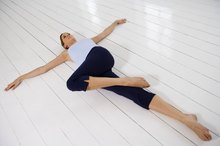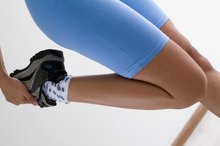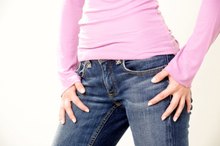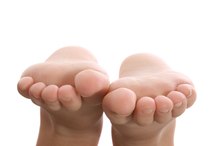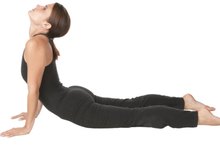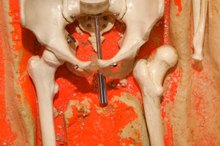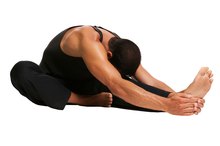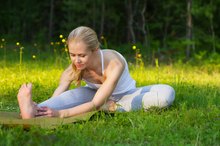Exercises for Contracted Muscles Behind the Knee
Hamstrings and calf muscles are directly behind your knee. Contracted muscles result from tension and can cause muscle cramps. Stretching is needed to reduce the contraction and increase the flexibility of these muscles. Range of motion exercises, or stretching, assist in warming up your muscles. As always, check with your doctor prior to starting any exercise program.
Prone Wall Stretches
Stretch the back of your knee by doing a wall stretching exercise. Lay on your back on a flat surface near a wall. Place the heel of your compromised leg onto the wall. Do not bend your knee. Increase the stretch by moving your body closer to the wall. Hold the stretch for 30 seconds. Slowly move your body away from the wall, decreasing your stretch. Lay your leg flat against the surface. Rest for one minute. Repeat this exercise eight times. As your knee becomes stronger, increase your stretch by moving your leg toward your upper body. Keep your knee straight while doing this.
Foot Stool Stretching
Exercises for Sciatic Nerve Spasms
Learn More
Stretch your contracted hamstrings by using a foot stool. Place your leg onto a foot stool. Straighten your leg as much as possible. Slowly bend your upper body forward. Bring your head as close as possible towards your leg. You will feel the stretch along the backside of your knee. Hold this stretch for 10 seconds. Slowly return your upper body to the standing position. Remove your leg from the stool, returning your leg to the floor. Relax for 20 seconds. Repeat this exercise 10 times.
Leg to Chest Maneuver
Loosen your contracted hamstrings by doing leg-to-chest stretches. Sit upright in a firm chair. Place both feet firmly on the floor. Slowly lift the leg with the contracted muscles off the floor. Bend your knee as you lift your leg toward your chest. Place your hands behind your knee to increase the stretch. Hold this stretch for five seconds. Slowly return your leg to the original position. Relax for 10 seconds. Repeat this exercise eight times.
Knee Extension
Stretching Exercises for ACL Injuries
Learn More
Help straighten your contracted muscles by doing a passive extension. Lay on a flat surface on your back. Extend your legs. Let your leg stretch itself naturally. Hold this stretch for five seconds. Gently bend your knee to relieve the tension. Relax for 10 seconds. Repeat this exercise five times. Do another knee extension by using a pillow. Place the ankle of the leg with the contracted muscles onto a pillow. Let your knee naturally stretch out. Hold this stretch for eight seconds. Remove the pillow and gently bend your knee. Relax for 10 seconds. Repeat this exercise five times.
Upright Wall Stretch
Stretch your calf muscles by using a wall. Stand three feet from the wall. Open your palms and place your hands onto the wall at shoulder level. Slowly lean forward while bending your elbows. Do not bend your knees or upper body. Keep your heels on the surface. Feel the stretch along the back of your legs. Hold this stretch for 20 seconds. Return your body to the original position. Repeat this exercise 10 times.
Related Articles
References
Writer Bio
Crystal Welch has a 30-year writing history. Her more than 2,000 published works have been included in the health and fitness-related Wellness Directory, Earthdance Press and Higher Source. She is an award-winning writer who teaches whole foods cooking and has written a cookbook series. She operates an HON-code-certified health-related blog with more than 95,000 readers. Welch has a B.B.A. from Eastern Michigan University.
